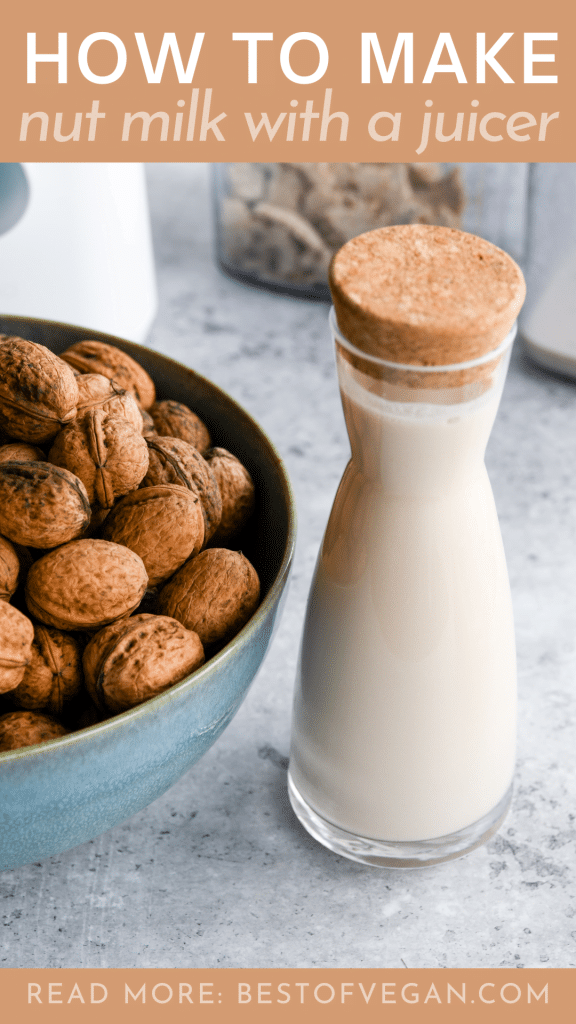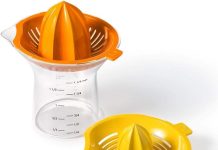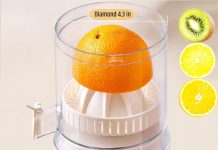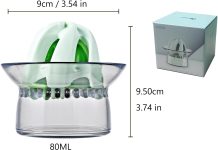Looking to expand your homemade milk options? Look no further! In this article, we explore the question on everyone’s mind: can you make nut milk with a juicer? We dive into the world of juicers and nut milk, discussing the advantages and potential challenges of using a juicer to create this creamy, plant-based beverage. Get ready to discover a fresh and efficient way to satisfy your nut milk cravings!
This image is property of bestofvegancom.lightningbasecdn.com.
Review contents
Why Use a Juicer?
Efficiency
Using a juicer to make nut milk offers several advantages, starting with its efficiency. Juicers are specifically designed to extract liquid from various ingredients, including nuts. Their powerful motors and specialized juicing mechanisms ensure that the maximum amount of liquid is extracted from the nuts, resulting in a higher yield of nut milk compared to other methods.
Time-saving
Another key benefit of using a juicer is the time-saving aspect. Making nut milk can be a time-consuming process, especially if using traditional methods like blending or hand-mixing. However, with a juicer, the process becomes much quicker and more streamlined. The juicer’s efficient extraction process allows for a faster production of nut milk, saving us precious time in the kitchen.
Extracting nutrients
Using a juicer can also maximize the extraction of nutrients from the nuts. The powerful juicing mechanism ensures that the nuts are thoroughly processed, breaking them down and releasing their valuable nutrients into the liquid. This means that homemade nut milk made with a juicer can offer a higher concentration of nutrients compared to store-bought alternatives.
Versatility
One of the standout advantages of using a juicer is its versatility. While primarily known for juicing fruits and vegetables, juicers can also be used to make various types of nut milk. Whether it’s almond milk, cashew milk, hazelnut milk, macadamia milk, or coconut milk, a juicer can handle them all. This versatility makes a juicer a valuable addition to any kitchen, allowing us to experiment with different types of nut milk and enjoy a wide range of flavors.
Types of Nut Milk
Almond milk
Almond milk is one of the most popular types of nut milk and is known for its mild, slightly sweet flavor. Made from soaked almonds and filtered water, it is usually a staple in many households due to its versatility and health benefits.
Cashew milk
Cashew milk is another delicious and creamy alternative to dairy milk. It has a smooth texture and a slightly nutty taste. Made from soaked cashews and water, it can be enjoyed on its own or used in various recipes like smoothies, desserts, and sauces.
Hazelnut milk
For those who love the rich and distinct flavor of hazelnuts, hazelnut milk is a delightful choice. Made from soaked hazelnuts and water, it has a slightly sweet and nutty flavor that can be a great addition to coffee, hot chocolate, or cereal.
Macadamia milk
Macadamia milk offers a creamy and smooth texture with a subtle and buttery taste. Made from soaked macadamia nuts and water, it is an excellent dairy-free alternative for those looking for a luxurious and indulgent nut milk option.
Coconut milk
Although technically not a nut, coconut milk is often included in the category of nut milk due to its similar uses and characteristics. It is made from the meat of mature coconuts and has a rich, creamy texture with a mild tropical flavor.
Requirements for Making Nut Milk
Raw nuts
To make nut milk with a juicer, the first requirement is using raw nuts. Raw nuts ensure that we have full control over the quality and flavor of the nut milk. They should be fresh and free from any rancidity or additives.
Filtered water
Using filtered water is essential for achieving a clean and pure taste in the nut milk. Tap water often contains various impurities that can interfere with the flavor and overall quality of the milk. By opting for filtered water, we ensure that our nut milk tastes deliciously fresh.
Sweeteners (optional)
While not necessary, sweeteners can be added to enhance the taste of nut milk. Common options include dates, honey, maple syrup, or agave nectar. Adding sweeteners is entirely optional and can be adjusted according to personal preference.
Flavorings (optional)
Similarly, flavorings can be added to give the nut milk a unique twist. Options like vanilla extract, cinnamon, or cocoa powder can be mixed in to create different flavors and variations.
Nut milk bag or cheesecloth
To strain the nut milk and separate it from the pulp, a nut milk bag or cheesecloth is necessary. These fine mesh materials ensure that the liquid is strained thoroughly, leaving behind a smooth and creamy milk.
Using a Juicer to Make Nut Milk
Step 1: Soaking the nuts
Before juicing the nuts, they need to be soaked. Soaking nuts helps to soften them, making it easier for the juicer to extract the liquid. Fill a container with filtered water and add the nuts, ensuring they are fully submerged. Let them soak for at least 4-6 hours or overnight for best results.
Step 2: Preparing the juicer
Next, prepare the juicer by assembling its parts according to the manufacturer’s instructions. Ensure that the juicer is clean and free from any debris or residue. Place a container or pitcher under the juicer’s spout to collect the extracted nut milk.
Step 3: Juicing the nuts
After the nuts have finished soaking, drain and rinse them thoroughly. Transfer the soaked nuts into the juicer’s feeding chute, ensuring that they are evenly spread to promote efficient juicing. Turn on the juicer and begin the extraction process, pushing the nuts down gently with the juicer’s plunger.
Step 4: Straining the milk
Once the nuts are juiced, it’s time to strain the milk. Place a nut milk bag or cheesecloth over another container or pitcher. Pour the juiced mixture into the bag or cheesecloth, allowing the liquid to pass through while trapping the pulp. Gently squeeze the bag or cheesecloth to extract every last drop of nut milk.
Step 5: Flavoring and sweetening (optional)
At this point, the nut milk can be enjoyed as-is or customized with additional flavors and sweeteners. Add your preferred sweetener, such as dates or maple syrup, and any desired flavorings, like vanilla extract or cocoa powder. Stir well to incorporate the flavors into the milk.
Step 6: Storing the nut milk
Transfer the freshly made nut milk to a clean, airtight container. Store it in the refrigerator and consume within 3-4 days for optimal freshness. Shake the container before each use, as separation may occur.
This image is property of i.ytimg.com.
Pros of Making Nut Milk with a Juicer
Efficient extraction
Using a juicer allows for efficient extraction of nut milk, resulting in a higher yield compared to other methods. The juicer’s powerful motor and specialized juicing mechanism ensure that a significant amount of liquid is extracted from the nuts, maximizing the efficiency of the process.
Smooth texture
Nut milk made with a juicer tends to have a smoother texture compared to other methods. The juicer’s extraction process breaks down the nuts thoroughly, resulting in a finer consistency and a creamier mouthfeel. This smooth texture enhances the overall drinking experience and makes the nut milk more enjoyable.
Convenient cleaning
Cleaning a juicer after making nut milk is relatively easy and convenient. Most juicer parts can be easily disassembled and washed separately. By following the manufacturer’s instructions, cleaning the juicer can be done in a few simple steps, allowing us to spend more time enjoying our freshly made nut milk and less time on cleanup.
Ability to customize flavors
Making nut milk with a juicer provides the opportunity to customize flavors according to individual preferences. By adding different sweeteners and flavorings, we can create a variety of nut milk flavors, catering to specific tastes or experimentation with unique combinations.
Multi-purpose functionality
Aside from making nut milk, a juicer can be used for a multitude of purposes. With interchangeable attachments, juicers can easily handle fruits, vegetables, and leafy greens, allowing us to enjoy a wide range of juices and smoothies. This versatility makes a juicer a valuable addition to any kitchen, offering multiple benefits beyond just nut milk extraction.
Cons of Making Nut Milk with a Juicer
Potential waste
While juicers are efficient at extracting liquid from nuts, there is still a potential for waste. Some residual pulp may remain after the juicing process, resulting in a small amount of leftover pulp that cannot be converted into milk. However, this leftover pulp can still be repurposed for other uses, minimizing any potential waste.
Requirement for soaking
One of the downsides of using a juicer is the requirement for soaking the nuts. Soaking helps soften the nuts and improve the juicing process, but it also adds additional time to the overall preparation. Planning ahead and allowing for the soaking time is necessary for successfully making nut milk with a juicer.
Higher initial cost
Compared to other methods of making nut milk, using a juicer may require a higher initial investment. Juicers can vary greatly in price depending on their features and capabilities. However, it’s important to consider the long-term benefits and versatility of a juicer, as it can be used for various other juicing needs beyond nut milk.
Limited quantity
Another potential drawback of making nut milk with a juicer is the limited quantity produced at a time. Juicers are typically designed for small to medium batches, and larger quantities may require multiple rounds of juicing. Therefore, if a large quantity of nut milk is desired, it may take additional time and effort to produce.
This image is property of bestofvegancom.lightningbasecdn.com.
Tips and Tricks
Using leftover pulp
Instead of wasting the leftover pulp, it can be repurposed in various ways. The pulp can be used in baking, added to oatmeal or smoothies, or even used as a base for homemade nut-based granola or energy bars. Get creative and find ways to minimize waste by incorporating the pulp into different recipes.
Experimenting with nut ratios
Feel free to experiment with different ratios of nuts to water when making nut milk. This allows for customization of the milk’s consistency and flavor. Adjusting the ratio can result in a thicker or thinner milk, depending on personal preference.
Adding natural thickeners
To achieve a creamier and thicker texture, consider adding natural thickeners like soaked chia seeds, flax seeds, or oats. These ingredients can improve the mouthfeel of the nut milk and offer additional nutritional benefits.
Trying different flavor combinations
Don’t be afraid to try different flavor combinations to create unique and delicious nut milk flavors. Whether it’s adding spices like turmeric or ginger, or experimenting with fruits like berries or mangoes, the possibilities are endless. Let your taste buds guide you and have fun creating your own signature nut milk blends.
Making flavored ice cubes
To enhance the flavor of your nut milk without diluting it, try making flavored ice cubes. Freeze small batches of your preferred flavors, such as coffee, chocolate, or fruit puree, and add them to your nut milk when serving. This adds an extra dimension of flavor and keeps the milk chilled without watering it down.
Nut Milk Recipes
Classic almond milk
Ingredients:
- 1 cup raw almonds
- 4 cups filtered water (plus extra for soaking)
- Optional: sweetener (dates, maple syrup, etc.), flavorings (vanilla extract, cinnamon, etc.)
Instructions:
- Soak the raw almonds in filtered water for at least 4-6 hours or overnight.
- Drain and rinse the soaked almonds.
- Prepare the juicer and assemble its parts according to the manufacturer’s instructions.
- Juice the soaked almonds by feeding them into the juicer’s chute. Use the plunger to push them down gently.
- Strain the resulting liquid using a nut milk bag or cheesecloth.
- Optional: Add sweetener and flavorings according to taste preferences.
- Transfer the freshly made almond milk to a clean, airtight container and store it in the refrigerator.
Creamy cashew milk
Ingredients:
- 1 cup raw cashews
- 4 cups filtered water (plus extra for soaking)
- Optional: sweetener (dates, honey, etc.), flavorings (vanilla extract, cocoa powder, etc.)
Instructions:
- Soak the raw cashews in filtered water for at least 4-6 hours or overnight.
- Drain and rinse the soaked cashews.
- Prepare the juicer and assemble its parts according to the manufacturer’s instructions.
- Juice the soaked cashews by feeding them into the juicer’s chute. Use the plunger to push them down gently.
- Strain the resulting liquid using a nut milk bag or cheesecloth.
- Optional: Add sweetener and flavorings according to taste preferences.
- Transfer the freshly made cashew milk to a clean, airtight container and store it in the refrigerator.
Indulgent chocolate hazelnut milk
Ingredients:
- 1 cup raw hazelnuts
- 4 cups filtered water (plus extra for soaking)
- 2 tablespoons cocoa powder
- Optional: sweetener (dates, maple syrup, etc.), flavorings (vanilla extract, sea salt, etc.)
Instructions:
- Soak the raw hazelnuts in filtered water for at least 4-6 hours or overnight.
- Drain and rinse the soaked hazelnuts.
- Prepare the juicer and assemble its parts according to the manufacturer’s instructions.
- Juice the soaked hazelnuts by feeding them into the juicer’s chute. Use the plunger to push them down gently.
- Strain the resulting liquid using a nut milk bag or cheesecloth.
- Stir in cocoa powder and optional sweetener and flavorings according to taste preferences.
- Transfer the freshly made chocolate hazelnut milk to a clean, airtight container and store it in the refrigerator.
Exotic macadamia milk
Ingredients:
- 1 cup raw macadamia nuts
- 4 cups filtered water (plus extra for soaking)
- Optional: sweetener (dates, honey, etc.), flavorings (vanilla extract, coconut flakes, etc.)
Instructions:
- Soak the raw macadamia nuts in filtered water for at least 4-6 hours or overnight.
- Drain and rinse the soaked macadamia nuts.
- Prepare the juicer and assemble its parts according to the manufacturer’s instructions.
- Juice the soaked macadamia nuts by feeding them into the juicer’s chute. Use the plunger to push them down gently.
- Strain the resulting liquid using a nut milk bag or cheesecloth.
- Optional: Add sweetener and flavorings according to taste preferences.
- Transfer the freshly made macadamia milk to a clean, airtight container and store it in the refrigerator.
Refreshing coconut milk
Ingredients:
- 1 cup raw, unsweetened shredded coconut
- 4 cups filtered water (plus extra for soaking)
- Optional: sweetener (dates, agave nectar, etc.), flavorings (vanilla extract, lime zest, etc.)
Instructions:
- Soak the shredded coconut in filtered water for 30 minutes to 1 hour.
- Drain and rinse the soaked coconut.
- Prepare the juicer and assemble its parts according to the manufacturer’s instructions.
- Juice the soaked coconut by feeding it into the juicer’s chute. Use the plunger to push it down gently.
- Strain the resulting liquid using a nut milk bag or cheesecloth.
- Optional: Add sweetener and flavorings according to taste preferences.
- Transfer the freshly made coconut milk to a clean, airtight container and store it in the refrigerator.
This image is property of i.ytimg.com.
Alternative Methods for Making Nut Milk
Blending with a high-speed blender
For those without a juicer, a high-speed blender can also be used to make nut milk. Soaked nuts and filtered water are blended together until thoroughly mixed. The resulting mixture is then strained using a nut milk bag or cheesecloth, similar to the juicer method.
Using a food processor
Although less ideal, a food processor can also be used to make nut milk. However, the resulting texture may be slightly grainier compared to using a juicer or blender. Soaked nuts and filtered water are processed in the food processor until well combined, followed by straining with a nut milk bag or cheesecloth.
Hand-mixing with a whisk
The most basic and traditional method for making nut milk is by hand-mixing using a whisk. Soaked nuts and filtered water are combined in a bowl, and a whisk is used to vigorously mix the ingredients until well blended. The resulting mixture is then strained through a nut milk bag or cheesecloth to separate the milk from the pulp.
Conclusion
In conclusion, using a juicer to make nut milk offers several advantages in terms of efficiency, time-saving, nutrient extraction, and versatility. Whether it’s almond milk, cashew milk, hazelnut milk, macadamia milk, or coconut milk, a juicer can handle them all with ease. While there are a few cons to consider, such as potential waste and the requirement for soaking, the pros outweigh them, making a juicer a valuable tool for nut milk enthusiasts.
By following the step-by-step guide for using a juicer to make nut milk, we can enjoy the benefits of efficient extraction, smooth texture, convenient cleaning, and the ability to customize flavors. Additionally, alternative methods like blending, using a food processor, or hand-mixing with a whisk can be utilized if a juicer is not available.
With the provided nut milk recipes and additional tips and tricks, we can experiment with different flavors, utilize leftover pulp creatively, and even try alternative thickening methods. Making nut milk at home allows us to have full control over the ingredients, ensuring a pure and delicious beverage that can be enjoyed on its own, used in recipes, or added to various beverages.
So, grab your juicer (or alternative equipment) and start creating creamy, nutritious, and flavorful nut milk right in the comfort of your own kitchen. Cheers to a healthier and tastier dairy-free alternative!
This image is property of i.ytimg.com.






































